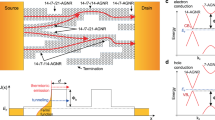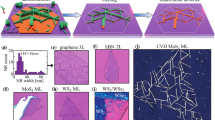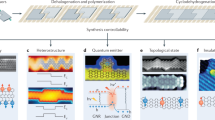Abstract
Despite graphene's remarkable electronic properties1,2, the lack of an electronic bandgap severely limits its potential for applications in digital electronics3,4. In contrast to extended films, narrow strips of graphene (called graphene nanoribbons) are semiconductors through quantum confinement5,6, with a bandgap that can be tuned as a function of the nanoribbon width and edge structure7,8,9,10. Atomically precise graphene nanoribbons can be obtained via a bottom-up approach based on the surface-assisted assembly of molecular precursors11. Here we report the fabrication of graphene nanoribbon heterojunctions and heterostructures by combining pristine hydrocarbon precursors with their nitrogen-substituted equivalents. Using scanning probe methods, we show that the resulting heterostructures consist of seamlessly assembled segments of pristine (undoped) graphene nanoribbons (p-GNRs) and deterministically nitrogen-doped graphene nanoribbons (N-GNRs), and behave similarly to traditional p–n junctions12. With a band shift of 0.5 eV and an electric field of 2 × 108 V m–1 at the heterojunction, these materials bear a high potential for applications in photovoltaics and electronics.
This is a preview of subscription content, access via your institution
Access options
Subscribe to this journal
Receive 12 print issues and online access
$259.00 per year
only $21.58 per issue
Buy this article
- Purchase on Springer Link
- Instant access to full article PDF
Prices may be subject to local taxes which are calculated during checkout




Similar content being viewed by others
References
Morzov, S. V. et al. Giant intrinsic carrier mobilities in graphene and its bilayer. Phys. Rev. Lett. 100, 016602 (2008).
Novoselov, K. S. et al. Electric field effect in atomically thin carbon films. Science 306, 666–669 (2004).
Castro Neto, A. H., Guinea, F., Peres, N. M. R., Novoselov, K. S. & Geim, A. K. The electronic properties of graphene. Rev. Mod. Phys. 81, 109–162 (2009).
Kotov, V. N., Uchoa, B., Pereira, V. M., Guinea, F. & Castro Neto, A. H. Electron–electron interactions in graphene: current status and perspectives. Rev. Mod. Phys. 84, 1067–1125 (2012).
Wakabayashi, K. Electronic transport properties of nanographite ribbon junctions. Phys. Rev. B 64, 125428 (2001).
Barone, V., Hod, O. & Scuseria, G. E. Electronic structure and stability of semiconducting graphene nanoribbons. Nano Lett. 6, 2748–2754 (2006).
Chen, Y. et al. Tuning the band gap of graphene nanoribbons synthesized from molecular precursors. ACS Nano 7, 6123–6128 (2013).
Son, Y. W., Cohen, M. L. & Louie, S. G. Half-metallic graphene nanoribbons. Nature 444, 347–349 (2006).
Yang, L. et al. Quasiparticle energies and band gaps in graphene nanoribbons. Phys. Rev. Lett. 99, 186801 (2007).
Ruffieux, P. et al. Electronic structure of atomically precise graphene nanoribbons. ACS Nano 6, 6930–6935 (2012).
Cai, J. et al. Atomically precise bottom-up fabrication of graphene nanoribbons. Nature 466, 470–473 (2010).
Kittel, C. Introduction to Solid State Physics 5th edn (Wiley, 1976).
Girao, E. C., Liang, L., Cruz-Silva, E., Souza Filho, A. G. Meunier, V. Emergence of atypical properties in assembled graphene nanoribbons. Phys. Rev. Lett. 107, 135501 (2011).
Wang, X. R. et al. N-doping of graphene through electrothermal reactions with ammonia. Science 324, 768–771 (2009).
Panchakarla, L. S. et al. Synthesis, structure, and properties of boron- and nitrogen-doped graphene. Adv. Mater. 21, 4726–4730 (2009).
Wei, D. C. et al. Synthesis of N-doped graphene by chemical vapor deposition and its electrical properties. Nano Lett. 9, 1752–1758 (2009).
Braun, K. F. & Rieder, K. H. Engineering electronic lifetimes in artificial atomic structures. Phys. Rev. Lett. 88, 096801 (2002).
Yan, Q. M. et al. Intrinsic current–voltage characteristics of graphene nanoribbon transistors and effect of edge doping. Nano Lett. 7, 1469–1473 (2007).
Li, Y. F. et al. Spin gapless semiconductor–metal–half-metal properties in nitrogen-doped zigzag graphene nanoribbons. ACS Nano 3, 1952–1958 (2009).
Boukhvalov, D. W. & Katsnelson, M. I. Chemical functionalization of graphene with defects. Nano Lett. 8, 4373–4379 (2008).
Yu, S. S. et al. First principle calculations of the electronic properties of nitrogen-doped carbon nanoribbons with zigzag edges. Carbon 46, 537–543 (2008).
Cocchi, C., Ruini, A., Prezzi, D., Caldas, M. J. & Molinari, E. Designing all-graphene nanojunctions by covalent functionalization. J. Phys. Chem. C 115, 2969–2973 (2011).
Neamen, D. A. Semiconductor Physics and Devices: Basic Principles 3rd edn (McGraw-Hill, 2003).
Nag, B. R. Physics of Quantum Well Devices (Springer, 2000).
Bronner, C. et al. Aligning the band gap of graphene nanoribbons by monomer doping. Angew. Chem. Int. Ed. 52, 4422–4425 (2013).
Bennett, P. B. et al. Bottom-up graphene nanoribbon field-effect transistors. Appl. Phys. Lett. 103, 253114 (2013).
Goedecker, S., Teter, M. & Hutter, J. Separable dual-space Gaussian pseudopotentials. Phys. Rev. B 54, 1703–1710 (1996).
Perdew, J. P., Burke, K. & Wang, Y. Generalized gradient approximation for the exchange-correlation hole of a many-electron system. Phys. Rev. B 54, 16533–16539 (1996).
Giannozzi, P. et al. Quantum espresso: a modular and open-source software project for quantum simulations of materials. J. Phys. Condens. Matter 21, 395502 (2009).
VandeVondele, J. et al. Fast and accurate density functional calculations using a mixed Gaussian and plane waves approach. Comput. Phys. Commun. 167, 103–128 (2005).
Acknowledgements
This work was supported by the Swiss National Science Foundation, by the State Secretariat for Education, Research and Innovation via the COST Action MP0901 ‘NanoTP’, by the European Science Foundation under the EUROCORES Program EuroGRAPHENE (GOSPEL), ERC NANOGRAPH, EU GENIUS project, Graphene Flagship and by the Office of Naval Research BRC Program. The Swiss Supercomputing Center, CSCS, is acknowledged for computational support (project s507). The authors thank D. Passerone for stimulating discussion. J.C. thanks R. Widmer, J. Liu and C. Sánchez for help with the experiments.
Author information
Authors and Affiliations
Contributions
J.C., P.R, R.F., X.F. and K.M. conceived and designed the experiments. R.B. synthesized the molecular precursors. J.C. performed the growth and scanning-probe experiments. J.C. and H.S. did the scanning tunnelling spectroscopy analysis. R.L. and X.F. developed the transfer process and performed the Raman measurements. C.A.P., L.T., L.L. and V.M. performed the simulations. J.C. and R.F. prepared the figures and wrote the paper. All authors discussed the results and implications, and commented on the manuscript.
Corresponding authors
Ethics declarations
Competing interests
The authors declare no competing financial interests.
Supplementary information
Supplementary information
Supplementary Information (PDF 1439 kb)
Rights and permissions
About this article
Cite this article
Cai, J., Pignedoli, C., Talirz, L. et al. Graphene nanoribbon heterojunctions. Nature Nanotech 9, 896–900 (2014). https://doi.org/10.1038/nnano.2014.184
Received:
Accepted:
Published:
Issue Date:
DOI: https://doi.org/10.1038/nnano.2014.184
This article is cited by
-
Molecular sensitised probe for amino acid recognition within peptide sequences
Nature Communications (2023)
-
A metal-free photoactive nitrogen-doped carbon nanosolenoid with broad absorption in visible region for efficient photocatalysis
Nature Communications (2023)
-
Band gap tuning and variable quantum barrier of armchair graphene nanoribbons by inducing antidote topologies
Journal of Computational Electronics (2023)
-
0D/1D CdSe@CdS QDs/GONRs nanocatalyst for efficient photoelectrochemical water splitting
Applied Physics A (2023)
-
Topologically enhanced nonlinear optical response of graphene nanoribbon heterojunctions
Quantum Frontiers (2023)



